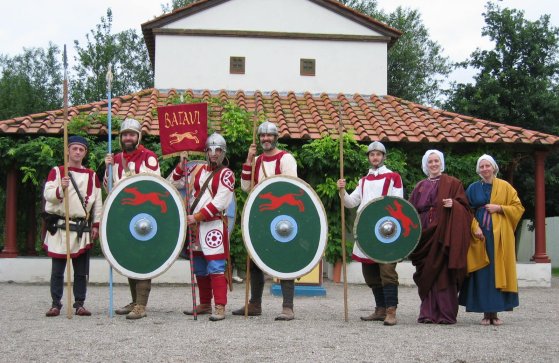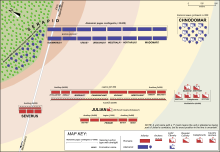Hello ladies and gents this is the viking telling you that today we are talking about

 The Batavi belonged to the army of the Caesar Julian, and fought in the Battle of Strasbourg (357). Deployed in the second line, together with the Regii, the Batavi sustained the assault of the outnumbering Alamannic infantry, which had broken the Roman first line. Pushed back until the hill where the Roman camp had been built, the Batavi were reinforced by the camp guards and repulsed and broke the enemy.
The Batavi belonged to the army of the Caesar Julian, and fought in the Battle of Strasbourg (357). Deployed in the second line, together with the Regii, the Batavi sustained the assault of the outnumbering Alamannic infantry, which had broken the Roman first line. Pushed back until the hill where the Roman camp had been built, the Batavi were reinforced by the camp guards and repulsed and broke the enemy.
The Batavi

The Batavi was an auxilia palatina (infantry) unit of the Late Roman army, active between the 4th and the 5th century. It was composed by 500 soldiers and was the heir of those ethnic groups that were initially used as auxiliary units of the Roman army and later integrated in the Roman Empire after the Constitutio Antoniniana. Their name was derived from the people of the Batavi.
In the sources they are usually recorded together with the Heruli, and it is probable the two units fought together.
At the beginning of the 5th century two related units are attested, the Batavi seniores and the Batavi iuniores.
Batavi
 The Batavi belonged to the army of the Caesar Julian, and fought in the Battle of Strasbourg (357). Deployed in the second line, together with the Regii, the Batavi sustained the assault of the outnumbering Alamannic infantry, which had broken the Roman first line. Pushed back until the hill where the Roman camp had been built, the Batavi were reinforced by the camp guards and repulsed and broke the enemy.
The Batavi belonged to the army of the Caesar Julian, and fought in the Battle of Strasbourg (357). Deployed in the second line, together with the Regii, the Batavi sustained the assault of the outnumbering Alamannic infantry, which had broken the Roman first line. Pushed back until the hill where the Roman camp had been built, the Batavi were reinforced by the camp guards and repulsed and broke the enemy.
In 360, before Julian received the order of sending most of his troops to emperor Constantius II of a campaign in the East, the Batavi, the Heruli and two numeri Moesiacorum were sent in Britain under the command of Lupicinus, Julian's magister militum, probably to counter a rebellion. Later the Batavi and the Heruli returned on the continent, but it is unknown when this happened.
Batavi seniores and iuniores
The Emperors Valentinian I and Valens divided the army among themselves. Many units were divided into two sub-units, sharing the name of the original unit and each distinguished by the name seniores, for the units of the senior Augustus Valentinian, and iuniores, for the units of the iunior Augustus Valens, and aggregated respectively to the Western Roman army and to the Eastern Roman army.[2]
Germanic situation circa 50 CE
In 365, when Emperor Valentinian I (364-375) had to confront the invading Germans and was defeated in battle, the inquires found that the Batavi (seniores) had been the first to flee. Before the whole army, Valentinian put the shame on the Batavi, and ordered to strip them of their arms and to sell them as runaway slaves. The soldiers of the legion bowed to the Emperor begging him to forgive them and give them an opportunity to redeem themselves and, at his invitation, took up arms, left the camp and attacked the enemies, killing the great part of them. It happened too (it is unclear whether at this time or not) that the barbarians were able to subtract the banner of the Batavi and Heruli units, which were made the object of derision by the raiders.
Military units
The first Batavi commander we know of is named Chariovalda, who led a charge across the Visurgin (Weser) against the Cherusci led by Arminius during the campaigns of Germanicus in Germania Transrhenana
Tacitus (De origine et situ Germanorum XXIX) described the Batavi as the bravest of the tribes of the area, hardened in the Germanic wars, with cohorts under their own commanders transferred to Britannia. They retained the honour of the ancient association with the Romans, not required to pay tribute or taxes and used by the Romans only for war:
"They furnished to the Empire nothing but men and arms", Tacitus remarked. Well regarded for their skills in horsemanship and swimming—for men and horses could cross the Rhine without losing formation, according to Tacitus. Dio Cassius describes this surprise tactic employed by Aulus Plautius against the "barbarians"—the British Celts— at the battle of the River Medway
The barbarians thought that Romans would not be able to cross it without a bridge, and consequently bivouacked in rather careless fashion on the opposite bank; but he sent across a detachment of Germanic tribesmen, who were accustomed to swim easily in full armour across the most turbulent streams. Thence the Britons retired to the river Thames at a point near where it empties into the ocean and at flood-tide forms a lake.
This they easily crossed because they knew where the firm ground and the easy passages in this region were to be found; but the Romans in attempting to follow them were not so successful. However, the Germans swam across again and some others got over by a bridge a little way up-stream, after which they assailed the barbarians from several sides at once and cut down many of them. (Cassius Dio, Roman History, Book 60:20)
It is uncertain how they were able to accomplish this feat. The late 4th century writer on Roman military affairs Vegetius mentions soldiers using reed rafts, drawn by leather leads, to transport equipment across rivers. But the sources suggest the Batavi were able to swim across rivers actually wearing full armour and weapons. This would only have been possible by the use of some kind of buoyancy device: Ammianus Marcellinus mentions that the Cornuti regiment swam across a river floating on their shields "as on a canoe" (357). Since the shields were wooden, they may have provided sufficient buoyancy
The Batavi were used to form the bulk of the Emperor's personal Germanic bodyguard from Augustus to Galba. They also provided a contingent for their indirect successors, the Emperor's horse guards, the Equites singulares Augusti. I hope you liked this post its a little different then what i usually do and as always have a chilled day from the viking.

Comments
Post a Comment